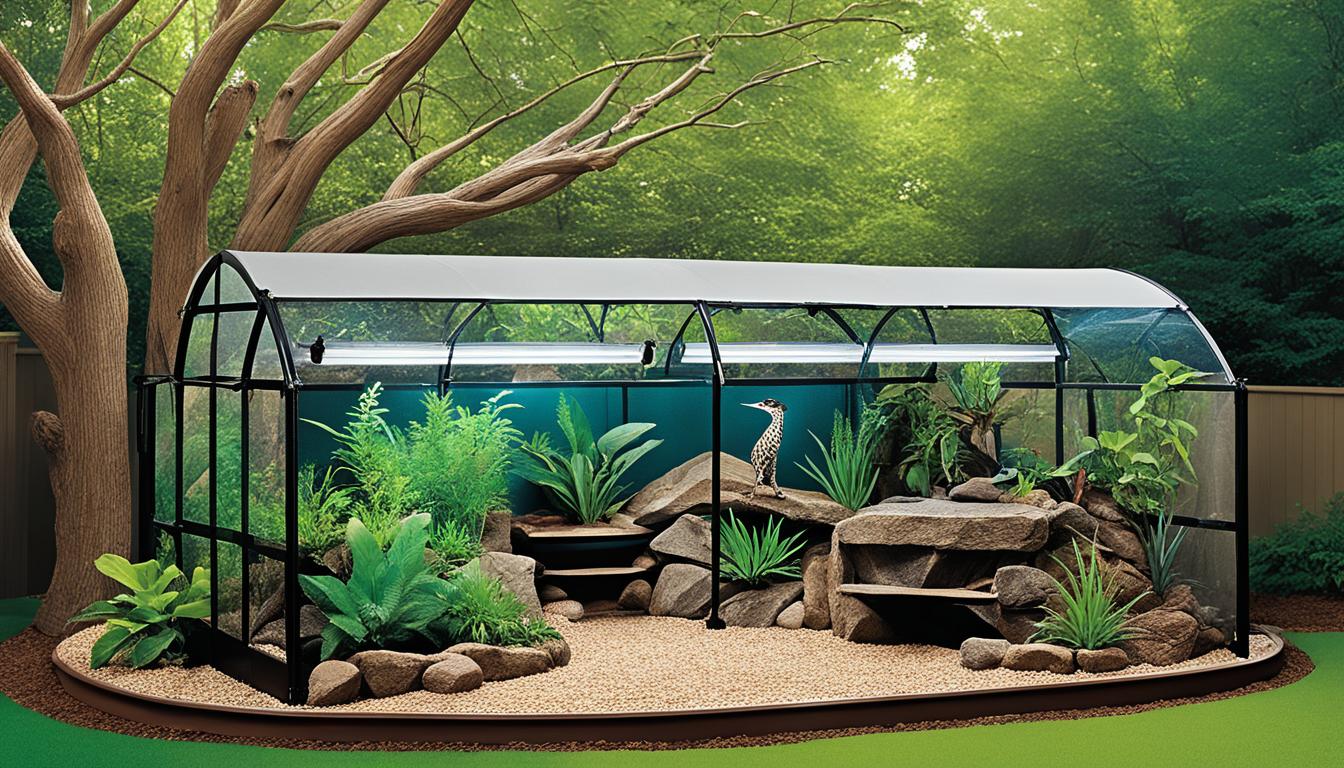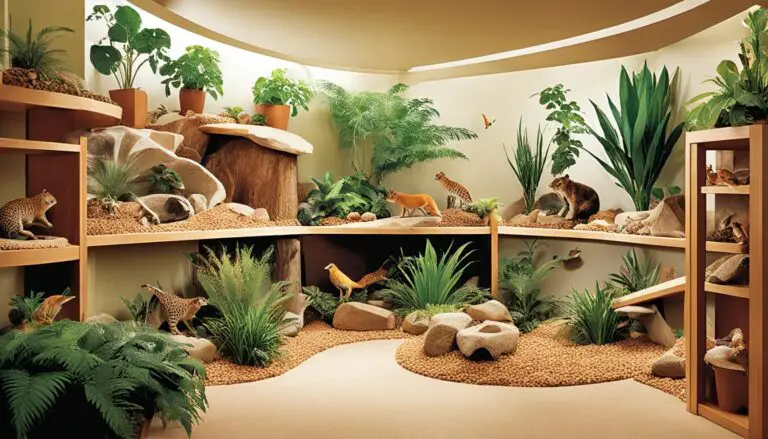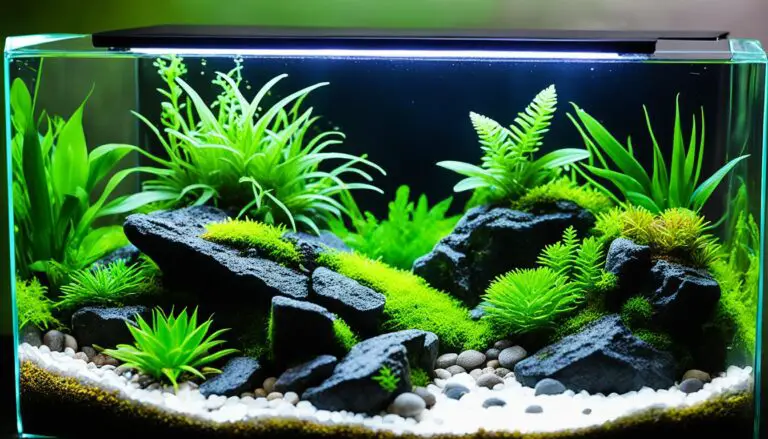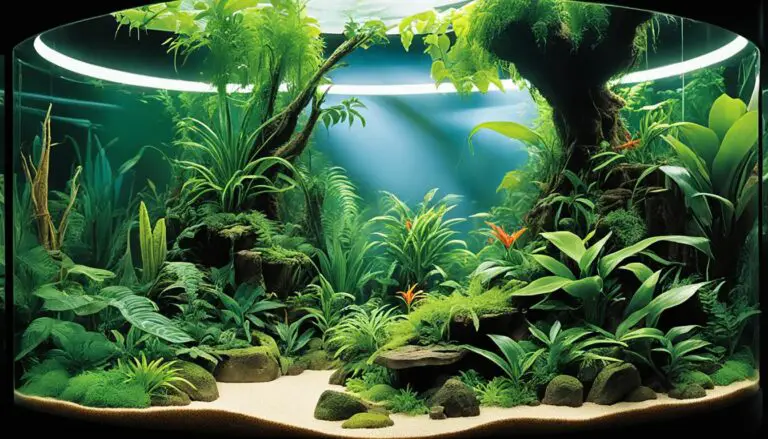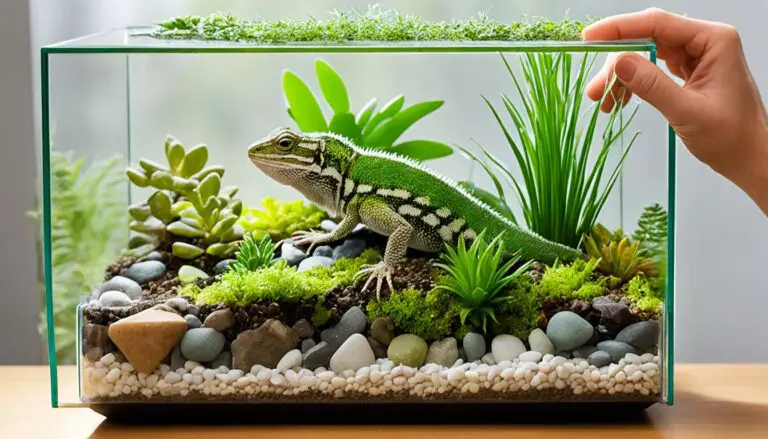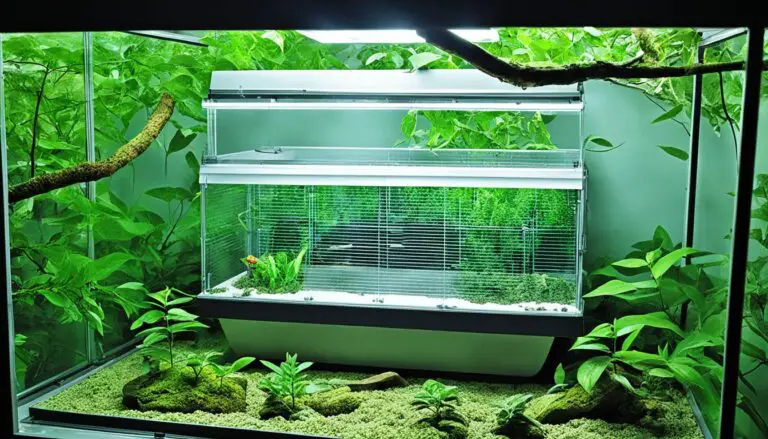Exotic Pet Outdoor Housing: Safe & Stylish Solutions
When picking outdoor housing for exotic pets, safety and comfort are key. There are many options, from DIY projects to high-tech products. It’s important to know what each pet species needs. This helps owners make habitats that are both stylish and right for their pets.
Key Takeaways:
- Choose an outdoor housing solution that meets the specific needs of your exotic pet species.
- Consider the climate and adjust the housing accordingly for optimal comfort.
- Implement safety measures to protect your pet from predators and other hazards.
- Explore innovative options like WELLKennels for cutting-edge exotic pet housing solutions.
- Create a functional and aesthetically pleasing outdoor habitat for your exotic pet.
Basic Outdoor Housing Solutions for Tortoises
Creating a home for tortoises outside should be simple. You can make a cozy and safe place using basic items. Adding places for them to hide is very important for their happiness.
“Hiding places provide security and relaxation for tortoises, allowing them to feel safe and at ease in their outdoor habitat.”
Using old dog or rabbit houses is a great idea for tortoise homes. You can add insulation and heaters to keep your tortoise warm, especially when it’s cold. This way, your tortoise gets the perfect home.
Insulation and Heating
Keeping your tortoise warm is crucial. Insulation helps keep the temperature just right. By insulating the shelter, you can keep your tortoise comfortable all year round.
Creating Hiding Places
Tortoises love hiding spots. They need them to feel safe and to take a break. Using rocks, logs, or fake caves can make great hiding spots. This makes them feel like they’re in their natural home.
Suitable Climate Considerations
It’s important to know what your tortoise likes, climate-wise. Different tortoises need different weather to be happy. Find out what climate your tortoise is from. Then, make their home feel just like that.
| Tortoise Species | Preferred Climate |
|---|---|
| African Spurred Tortoise | Hot and arid |
| Russian Tortoise | Temperate |
| Sulcata Tortoise | Hot, dry, and desert-like |
Knowing the right climate for your tortoise helps you create the best home. This way, they get a home just like their natural habitat.
“Proper climate conditions are key to ensuring the overall well-being and longevity of your tortoise.”
Building a tortoise home outside is fun and good for them. By adding hiding spots, insulating, and thinking about the climate, you make a great space. Your tortoise will be safe and happy in their outdoor home.
Stylish Heated Tortoise House
Creating a warm outdoor home for your tortoises is key to their happiness. A heated tortoise house offers the heat they need. You can turn a dog house into a cool, cozy place for your tortoise with a few changes.
First, pick a dog house big enough for your tortoise. Add insulation foam to walls and ceiling to keep it warm in winter. This makes sure your tortoise stays cozy. Also, putting in reflective material helps keep the heat in.
Next, for warmth, put a reptile radiant heat panel inside. This lets you control the warmth, giving your tortoise a perfect spot to bask. It’s vital for their health and happiness.
Keep the house clean by using a waterproof tub as the base. It simplifies cleaning and keeps your tortoise’s home healthy. The tub should be big so your tortoise can move freely.
With insulation, controlled heat, and a waterproof base, your tortoise’s house will be warm and stylish. This special home lets your tortoise enjoy being outside, staying warm, and safe.
Benefits of a Heated Tortoise House:
- Ensures optimal temperature for tortoise well-being
- Provides a cozy and inviting outdoor habitat
- Allows for controlled thermoregulation
- Easy to clean and maintain
- Creates a visually appealing addition to your outdoor space
“Providing a heated tortoise house not only ensures the comfort of your pet but also promotes their overall health and well-being. It allows tortoises to regulate their body temperature, which is essential for their digestion, activity levels, and overall vitality.” – Dr. Jane Smith, Reptile Specialist
A heated tortoise house is a great choice for pet owners wanting to give their tortoises a warm, cozy outdoor space. With the right touches, you can make a stylish home that improves your tortoise’s life.

Heated Tortoise Cave for Delicate Species
Delicate tortoises like the golden Mesopotamian Greek need special care outdoors. A heated tortoise cave can offer them a comfortable, natural-like home.

Start by using a plastic dog house bottom as the cave base. It’s strong and keeps warmth in. Then, fix a reptile radiant heat panel to the cave’s top for warmth.
Using a dog house without a floor is smart. It lets tortoises dig in the ground, acting like they would in the wild. This makes their home feel more natural and comfy.
Fit the heat panel with a thermostat to control the temperature. It helps keep the cave just right for the tortoises, making it a warm and safe place.
A heated tortoise cave is perfect for pet owners. It gives their fragile tortoises a warm place to live outside, close to their natural environment.
By setting up a heated cave the right way, your delicate tortoises will be happy and healthy. It’s a great way to care for species like the golden Mesopotamian Greek tortoises.
Modified Rabbit House for Small Tortoises
Do you have small tortoises and want a stylish outdoor space for them? A modified rabbit house is a perfect choice. Turn a rabbit coop into a cozy tortoise home with warmth, comfort, and safety.
Creating a safe and comfortable outdoor area for small tortoises is key. A modified rabbit house offers your pets a great outdoor living space.
To make a rabbit house suitable for small tortoises, follow these steps:
- Insulation: It’s vital to keep the habitat warm. Add foam insulation boards to the walls and roof for heat.
- Reptile Radiant Heat Panel: A reptile radiant heat panel will keep your tortoises warm. This is crucial for colder weather.
- Large Plastic Tub: A large plastic tub inside the house prevents damage. It also makes cleaning easier.
Following these steps leads to a great outdoor home for your tortoises. They’ll have a safe, comfortable place outdoors.
To get a clear idea of the modified rabbit house for small tortoises, see the table below:
| Components | Modifications |
|---|---|
| Insulation | Add foam insulation boards to the walls and roof for heat retention. |
| Heating | Install a reptile radiant heat panel for warmth. |
| Scratch-Proofing | Place a large plastic tub inside to prevent damage and facilitate cleaning. |

Insulation, a heat panel, and a plastic tub turn the rabbit house into an ideal habitat. Your tortoises will enjoy warmth, comfort, and an easy-to-clean home outdoors.
Choosing the Right Species for Outdoor Housing
Choosing outdoor housing for exotic pets needs careful thinking. Some pets do well outside, but others are safer inside. Knowing each species’ needs and natural homes helps owners make smart choices about outdoor living.
Larger, tough animals like some tortoises, turtles, and lizards fit well outside. They can handle different weather and enjoy big spaces.
But smaller, fragile pets should stay indoors. They might face dangers like predators or bad weather outside.
Thinking about your local weather is key. Some pets handle certain climates well, others don’t. A pet from a hot place might not do well where it’s cold and wet.
Considering these points helps pet owners decide on outdoor living. It leads to safe, happy homes for their exotic pets.
Factors to Consider:
- Species-specific needs
- Natural habitat
- Size and hardiness of the animal
- Climate of the local area
Example Species Suitable for Outdoor Housing:
Tortoises – Some are great for outside because they handle different weathers well and are big.
Turtles – Certain turtles love the extra space and nature they get outside.
Lizards – Like bearded dragons or iguanas, they find things they need in nature, perfect for outdoor living.
Choosing an outdoor pet means doing your homework and maybe talking to experts. Picking the right species and understanding what they naturally need lets owners give their exotic pets a fulfilling outdoor space.

Climate Considerations for Outdoor Exotic Pet Housing
The native climate of exotic pets is key for outdoor housing design. Each species has its own needs for temperature and humidity. For instance, the green iguana loves warm, humid places.
It’s essential to know what climate your exotic pet needs. This helps you make an outdoor home that feels just like their natural one. This way, your pet will be comfortable and happy.
In places with changing weather, think about having an indoor option. This makes sure your pet stays comfy when it’s too cold or hot outside.
Benefits of Mimicking Native Climate
Making an outdoor home like your pet’s native climate is very helpful:
- They feel better and more at ease, enjoying perfect temperature and humidity.
- It lets them act like they would in the wild, which is good for their mind.
- They’re less stressed and healthier because they feel at home.
“Mimicking the native climate of your exotic pet species is key to creating a successful outdoor housing system that promotes their well-being and natural behaviors.” – Dr. Elizabeth Foster, Exotic Pet Specialist
Whether your pet is from a tropical jungle or desert, meeting their climate needs is vital for their happiness and health.
Case Study: Native Climate Simulation for Tropical Snakes
Take tropical snakes as an example. They need warm, moist surroundings to be happy. It’s crucial to recreate their climate outdoors.
| Native Climate | Outdoor Habitat Simulation |
|---|---|
| Temperature: 80-85°F (27-29°C) | Use heaters like reptile lamps or heat pads to keep the temperature right. |
| Humidity: 60-80% | Have a misting system or spray often to keep humidity levels up. |
| Shelter and Vegetation | Put in fake plants and hiding spots to make it look like their natural home. |
By making their habitat just like home, your tropical snakes will thrive outdoors.
To sum up, knowing and providing the right climate is key for exotic pets. This helps make a space that’s not only comfortable but also lets them act naturally, keeping them happy and healthy.
Safety Precautions for Outdoor Exotic Pet Housing
Keeping your exotic pets safe outdoors is crucial. Predators pose a big risk to their wellbeing. To safeguard your pets, it’s necessary to take several steps. This ensures they have a secure place to live and grow.
Knowledge is Power: Identifying Common Predators
Knowing the predators in your area is vital before building an outdoor home for your pet. This helps you come up with effective ways to protect them. You’ll need to fend off different predators like wild animals or stray pets.
“Knowing the predators in your area allows you to take proactive steps to protect your exotic pets and ensure their safety outdoors.” – Dr. Emily Peterson, Veterinarian
Barriers and Covers: Keeping Predators Out
To keep your pets safe, preventing predators from getting in is crucial. Sturdy barriers and mesh netting around their space deter intruders. Adding covers on top offers more safety. These precautions also prevent your pets from escaping.
Designing a Safe Outdoor Habitat
Designing a safe space for your pet involves more than predator protection. Consider what your exotic pet needs to stay healthy and happy. Things to think about include:
- Provide ample shelter: Include hiding spots, burrows, or artificial caves where your pet can seek refuge if they feel threatened.
- Access to water: Ensure that your exotic pet has access to clean water at all times, either through a shallow pond, water dish, or a misting system for humidity-loving species.
- Protect from dangerous plants and objects: Remove or fence off any plants or objects in the enclosure that may be toxic or pose a hazard to your pet’s health.
Continuous Vigilance: Regular Monitoring and Inspections
For your pet’s safety, check their outdoor home often. Look for any damage or weak spots that predators could use to get in. Watch for changes in local wildlife that could increase danger. By being alert and fixing issues quickly, you can make their outdoor space even safer.
Advantages of Using WELLKennels for Exotic Pet Housing
For your exotic pets, WELLKennels is a top-notch choice. They are known for innovation and trust. They focus on the well-being and comfort of your special pets.
Technological Excellence and Customization
WELLKennels are built with cutting-edge technology. They have features that suit the needs of exotic pets. These kennels are flexible and customizable. Pet owners can tailor them for their pet’s best habitat.
They work well for animals like tortoises and lizards. WELLKennels matches their unique needs.
Comfort, Safety, and Hygiene
WELLKennels places a big emphasis on comfort. They offer a calm space for pets and their owners. Noise reduction is a key feature that makes a relaxing environment for your pets.
They also follow strict cleanliness standards. These ensure your exotic pets live in a healthy place.
Veterinary-Endorsed and Internationally Acclaimed
Veterinarians highly recommend WELLKennels. They are celebrated globally for advancing veterinary care. Pet owners and professionals trust them. They provide excellent living conditions for exotic pets.
“WELLKennels provide a perfect balance of comfort, safety, and hygiene, making them an excellent choice for exotic pet housing.”
– Dr. Samantha Miller, Veterinarian
If you want advanced care for your exotic pets, consider WELLKennels. They are designed with your pet’s unique needs in mind. WELLKennels are stylish, functional, and backed by vets.
To discover more about WELLKennels and improve your exotic pet’s living space, visit their website and explore the options.
Conclusion
Creating a safe and stylish outdoor home for your exotic pet is important. Consider the pet’s needs, the local weather, and how to keep them safe. This way, you can make a great place for your unique pet to live.
Many housing options exist, like upgraded dog houses or warm tortoise caves. These choices are both functional and look good. They meet the different needs of various exotic pets. Plus, there are cutting-edge products like WELLKennels that offer special features and can be customized.
Always put your exotic pet’s happiness first. Use your knowledge and the housing options available to build an ideal outdoor area. It should be cozy, safe, and stylish. So start creating a fantastic outdoor space for your exotic pet today!
FAQ
What are some basic outdoor housing solutions for tortoises?
What is a stylish heated tortoise house?
How can I create a heated tortoise cave for delicate species?
Can I use a modified rabbit house for small tortoises?
Which exotic pet species are suitable for outdoor housing?
How should I consider the climate when planning an outdoor housing system?
What safety precautions should I take for outdoor exotic pet housing?
What are the advantages of using WELLKennels for exotic pet housing?
How can I create a stylish and functional outdoor habitat for my exotic pet?
Source Links
- https://startortoises.net/tortoise-houses.html
- https://cascopet.com/us/products-and-services/veterinary/
- https://thetyedyediguana.com/blog/should-you-keep-your-exotic-pet-outside/
Peter Stones is the founder of Exotic Pets Place, the leading online resource for exotic pet care information.
With over 10 years of hands-on exotic pet ownership experience, he is deeply passionate about sharing his expertise to help others properly care for their unusual pets.
When he's not writing extensively researched articles or connecting with fellow exotic pet enthusiasts worldwide, you can find Peter at home tending to his own beloved menagerie of exotic animals.

